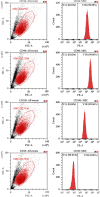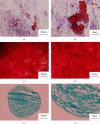Comparison between Intra-Articular Injection of Infrapatellar Fat Pad (IPFP) Cell Concentrates and IPFP-Mesenchymal Stem Cells (MSCs) for Cartilage Defect Repair of the Knee Joint in Rabbits
- PMID: 34367294
- PMCID: PMC8337123
- DOI: 10.1155/2021/9966966
Comparison between Intra-Articular Injection of Infrapatellar Fat Pad (IPFP) Cell Concentrates and IPFP-Mesenchymal Stem Cells (MSCs) for Cartilage Defect Repair of the Knee Joint in Rabbits
Abstract
Mesenchymal stem cells (MSCs) have emerged as a promising therapeutic method in regenerative medicine. Our previous research adopted a simple nonenzymatic strategy for the preparation of a new type of ready-to-use infrapatellar fat pad (IPFP) cell concentrates. The aim of this study was to compare the therapeutic efficacy of intra-articular (IA) injection of autologous IPFP cell concentrates and allogeneic IPFP-MSCs obtained from these concentrates in a rabbit articular cartilage defect model. IPFP-MSCs sprouting from the IPFP cell concentrates were characterized via flow cytometry as well as based on their potential for differentiation into adipocytes, osteoblasts, and chondrocytes. In the rabbit model, cartilage defects were created on the trochlear groove, followed by treatment with IPFP cell concentrates, IPFP-MSCs, or normal saline IA injection. Distal femur samples were evaluated at 6 and 12 weeks posttreatment via macroscopic observation and histological assessment based on the International Cartilage Repair Society (ICRS) macroscopic scoring system as well as the ICRS visual histological assessment scale. The macroscopic score and histological score were significantly higher in the IPFP-MSC group compared to the IPFP cell concentrate group at 12 weeks. Further, both treatment groups had higher scores compared to the normal saline group. In comparison to the latter, the groups treated with IPFP-MSCs and IPFP cell concentrates showed considerably better cartilage regeneration. Overall, IPFP-MSCs represent an effective therapeutic strategy for stimulating articular cartilage regeneration. Further, due to the simple, cost-effective, nonenzymatic, and safe preparation process, IPFP cell concentrates may represent an effective alternative to stem cell-based therapy in the clinic.
Copyright © 2021 Yaguang Han et al.
Conflict of interest statement
The authors declare that there is no conflict of interest regarding the publication of this paper.
Figures





Similar articles
-
Exosomes from Kartogenin-Pretreated Infrapatellar Fat Pad Mesenchymal Stem Cells Enhance Chondrocyte Anabolism and Articular Cartilage Regeneration.Stem Cells Int. 2021 Mar 9;2021:6624874. doi: 10.1155/2021/6624874. eCollection 2021. Stem Cells Int. 2021. PMID: 33763141 Free PMC article.
-
miR-100-5p-abundant exosomes derived from infrapatellar fat pad MSCs protect articular cartilage and ameliorate gait abnormalities via inhibition of mTOR in osteoarthritis.Biomaterials. 2019 Jun;206:87-100. doi: 10.1016/j.biomaterials.2019.03.022. Epub 2019 Mar 20. Biomaterials. 2019. PMID: 30927715
-
Culture of Mesenchymal Stem Cells Derived From the Infrapatellar Fat Pad Without Enzyme and Preliminary Study on the Repair of Articular Cartilage Defects in Rabbits.Front Bioeng Biotechnol. 2022 Aug 17;10:889306. doi: 10.3389/fbioe.2022.889306. eCollection 2022. Front Bioeng Biotechnol. 2022. PMID: 36061444 Free PMC article.
-
The Use of Infrapatellar Fat Pad-Derived Mesenchymal Stem Cells in Articular Cartilage Regeneration: A Review.Int J Mol Sci. 2021 Aug 26;22(17):9215. doi: 10.3390/ijms22179215. Int J Mol Sci. 2021. PMID: 34502123 Free PMC article. Review.
-
Potential of Using Infrapatellar-Fat-Pad-Derived Mesenchymal Stem Cells for Therapy in Degenerative Arthritis: Chondrogenesis, Exosomes, and Transcription Regulation.Biomolecules. 2022 Mar 1;12(3):386. doi: 10.3390/biom12030386. Biomolecules. 2022. PMID: 35327578 Free PMC article. Review.
Cited by
-
The influence of inflammation on the characteristics of adipose-derived mesenchymal stem cells (ADMSCs) and tissue repair capability in a hepatic injury mouse model.Stem Cell Res Ther. 2023 Nov 19;14(1):334. doi: 10.1186/s13287-023-03532-z. Stem Cell Res Ther. 2023. PMID: 37981679 Free PMC article.
-
Layer-specific stem cell differentiation in tri-layered tissue engineering biomaterials: Towards development of a single-stage cell-based approach for osteochondral defect repair.Mater Today Bio. 2021 Nov 27;12:100173. doi: 10.1016/j.mtbio.2021.100173. eCollection 2021 Sep. Mater Today Bio. 2021. PMID: 34901823 Free PMC article.
-
Localized delivery of brain-derived neurotrophic factor from PLGA microspheres promotes peripheral nerve regeneration in rats.J Orthop Surg Res. 2022 Mar 18;17(1):172. doi: 10.1186/s13018-022-02985-x. J Orthop Surg Res. 2022. PMID: 35303915 Free PMC article.
-
Evaluation of a co-culture of rapidly isolated chondrocytes and stem cells seeded on tri-layered collagen-based scaffolds in a caprine osteochondral defect model.Biomater Biosyst. 2022 Oct 8;8:100066. doi: 10.1016/j.bbiosy.2022.100066. eCollection 2022 Dec. Biomater Biosyst. 2022. PMID: 36824377 Free PMC article.
-
Tendon healing: a concise review on cellular and molecular mechanisms with a particular focus on the Achilles tendon.Bone Joint Res. 2022 Aug;11(8):561-574. doi: 10.1302/2046-3758.118.BJR-2021-0576.R1. Bone Joint Res. 2022. PMID: 35920195 Free PMC article.
References
LinkOut - more resources
Full Text Sources

